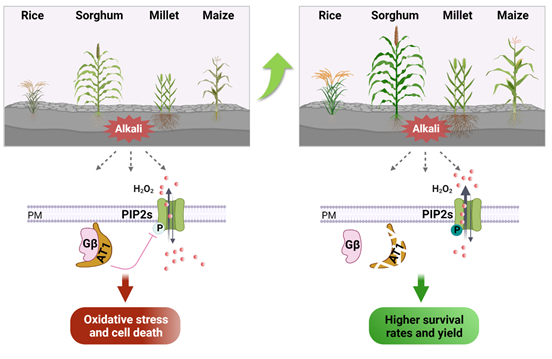10 scientific research units collaborated to tackle key problems, and two important papers were published together. For the first time, an important saline-alkali tolerance regulatory gene was discovered, which is of great significance to crop breeding and efficient use of saline-alkali land!

The Gγ subunit-encoded gene AT1 mediates the response mechanism of plants to alkali stress.
According to the official website of the Institute of Genetics and Developmental Biology, Chinese Academy of Sciences, Xie Qi's team and collaborators jointly tackled key problems and discovered an alkali resistance gene, named AT1 in sorghum, which is homologous to the rice grain shape regulation gene GS3.
The research team modified the above-mentioned genes in crops such as rice, corn, wheat, millet and sorghum, and conducted field experiments. The study found that rice, maize, sorghum and millet improved based on the salt-alkali tolerance allele AT1/GS3 all effectively increased the yield and biomass by about 20-30%.
The above research results were published online on March 24 in the international academic journals Science (DOI: 10.1126/science.ade8416) and National Science Review (DOI: 10.1093/nsr/nwad075) superior.
The relevant research was led by the Xie Qi team of the Institute of Genetics and Development of the Chinese Academy of Sciences, and cooperated with China Agricultural University, Huazhong Agricultural University, Institute of Biophysics of the Chinese Academy of Sciences, Modern Agricultural Research Institute of Peking University, Shandong University, Ningxia University, Northeast Institute of Geography of the Chinese Academy of Sciences, Yangzhou University, etc. 9 Scientific research units have completed collaborative research.
The Paper learned from the research team that researchers have done relatively more research on salt tolerance, but very little research on alkali resistance. Moreover, saline-alkali land is mainly divided into two types: neutral salt and alkaline salt. It is more difficult to "conquer" alkaline saline-alkali land (soda saline-alkali land with high pH) than neutral-pH salt land. Previously, people had discovered the GS3 gene, but in order to control the grain shape of rice, they never thought that it could regulate the salt-alkaline tolerance of crops. Why can the AT1/GS3 gene affect the salt-alkali tolerance of crops? It can affect the phosphorylation of aquaporin, thereby regulating the level of hydrogen peroxide in cells, and then affecting the fate of cells.
With the rapid increase of population and the decrease of per capita arable land and fresh water resources, by 2050, global crop production will need to double to meet human food needs.
Soil salinization has become a worldwide problem. According to the survey data of the Food and Agriculture Organization of the United Nations, as of 2015, more than 1 billion hectares of salinized soil in the world cannot be effectively used due to high salinity, and saline-alkali soil accounts for about 60% of the salinized soil. %. And unreasonable fertilization and irrigation will further exacerbate the expansion of saline-alkali land area.
Therefore, cultivating saline-alkali-tolerant crops and improving the productivity of salinized land is an important way to solve human food security and agricultural development in the future. Salinized land is divided into neutral pH saline (rich in sodium chloride and sodium sulfate) and high pH soda saline (rich in sodium carbonate and sodium bicarbonate, accounting for about 60%). At present, we have a relatively deep understanding of plant salt tolerance, but the understanding of plant alkali stress environment is seriously insufficient.
Sorghum, the fifth largest crop in the world, originated in Africa and is one of the earliest cultivated crops in the world. Sorghum has strong tolerance to salt, drought and poor soil, so far it is still the main food source in arid and semi-arid regions of the world. Sorghum belongs to Poaceae, with small genome and rich germplasm resources, so it can be used as an ideal model crop for mining salt-alkali tolerance gene resources.
Xie Qi's team at the Institute of Genetics and Developmental Biology, Chinese Academy of Sciences used sorghum resource populations, and through genome-wide association analysis, they first cloned a major locus that is significantly related to sorghum alkali resistance, named AT1, which encodes a heterologous three The polymeric G protein gamma subunit (Gγ) is homologous to the rice grain shape regulatory gene GS3. Haplotype analysis found that there was a natural variation with a frameshift mutation in the AT1 gene, which was extremely significantly correlated with the variation of salt-alkaline tolerance. Genetic materials such as AT1 overexpression, gene editing and near-isogenic lines of sorghum were constructed and analyzed for saline-alkali tolerance. It was found that AT1 played a negative regulatory role in the response to sorghum alkali stress. At the same time, it was found that the role of AT1/GS3 in negatively regulating alkali stress tolerance is highly conserved in other grass crops including rice, corn, wheat and millet.
In order to reveal the molecular mechanism of AT1 regulating plant alkaloid stress response, the interacting aquaporins SbPIP2;1/2;2 and SbPIP1;3/1;4 of AT1 were identified by co-immunoprecipitation combined with LC-MS protein profiling, and It was confirmed that AT1 interacted with them both in vitro and in vivo. Using the pH-insensitive H2O2-specific fluorescent probe Cyto-roGFP2-Orp1 to conduct experiments, it was found that under saline-alkali stress, PIP2;1 promotes the efflux of hydrogen peroxide (H2O2) to reduce the damage caused by alkali stress to cells, AT1 /GS3 affects the level of reactive oxygen species in cells by inhibiting the phosphorylation level of PIP2;1 protein. Therefore, under alkali stress conditions, AT1 may regulate the ROS homeostasis in plant cells by weakening the phosphorylation of PIP2; Saline and alkaline resistant.
Researchers predict that if 20% of the world's saline-alkali lands use the above-mentioned gene-related research results, it can increase global food production by at least 250 million tons per year.
The expansion of this work from sorghum to major food crops is a persistent effort in the direction of stress tolerance of laboratory plants. In addition, in the past few years, sorghum has been used to resolve many scientific issues in crops, such as the scientific mechanism of bird picky eating (Mol. Plant, 2019a) and the evolution mechanism of crop seed encrustation (Nat. Commun., 2022); sweet sorghum and The sustainable use of marginal land (Mol. Plant, 2019b) and the first fragrant sorghum created by gene editing (JIPB, 2022) and the promotion of 6 nationally approved varieties to more than 500,000 mu nationwide have been verified from basic theory to application .
The research was funded by the National Natural Science Foundation of China, the Key Strategic Key Project of the Chinese Academy of Sciences, the Ningxia Agricultural Breeding Project, and the Youth Innovation Promotion Association of the Chinese Academy of Sciences.






Comments